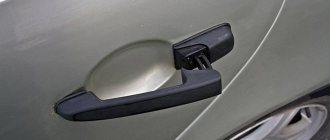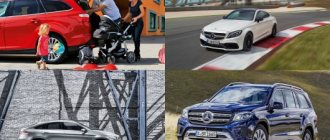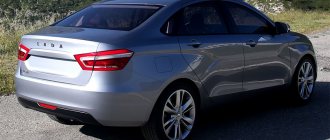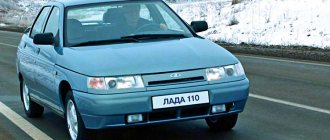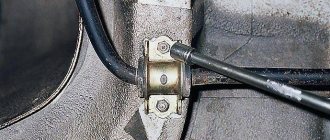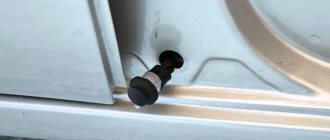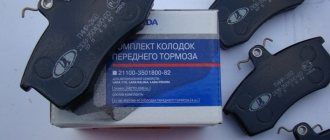Testing methodology
The car in question was destroyed in just one crash test. It was a frontal impact with a 40 percent overlap, and the car itself was accelerated to 64 km/h. Let us clarify once again - here we are talking about equipment 21942-42, equipped with pyrotechnic belt pretensioners. The wheels in this configuration are made of light alloy, which, in turn, could also affect the result.
Station wagon Kalina-2 Lux, photo from the official website
After gaining speed, the station wagon body encounters an obstacle that covers 40% of the space and is located on the driver’s side. This method of testing a car is close to the EuroNCAP methods used for a long time in Europe. What happened as a result is described in the next chapter. In fact, the Lada Kalina car received 3 stars out of 4 possible, which is not so bad. The Granta in the sedan body did not earn much more points, but it was tested using a similar method.
Crash test Kalina - Autoreview
The modernized Kalina, how is it better than the Grants in terms of passive safety and is it better at all? The AvtoVAZ moratorium prepared the Lux version station wagon with two airbags, and even with an automatic transmission, for the impact.
And we acted not just as observers, as in the case of Granta, in addition to our adult assistants Hybrid Three in the front seats.
On the back sofa we seated in the child's chairs the mannequins Q one and a half and Q three, simulating children aged one and a half and 3 years, respectively.
The Kalina, ready for a crash test, is one and a half times heavier than the Granta crashed in the Czech Republic. The car will hit the deformed aluminum honeycomb barrier with a 40 percent overlap at 64 km/h as usual.
The power structure of the body of Kalina and Grant is identical, the only difference is the headlights, bumper and wings, they have little effect on the result at such a high speed, and therefore the deformations of the side members should be similar.
Look, Kalina’s body is crushed exactly like Granta’s, the Toccata airbag is also fired at 28 milliseconds, taking the driver’s head exactly in the center.
Hick - the integral criterion for head damage was a safe 540 units, and Kalina’s more elastic, interior plastic made it possible to reduce the load on the knees and hips by 20% compared to Granta.
The passenger, protected by the second airbag, does not risk anything at all. It fires a little later than the driver’s, and if the driver’s feet and legs are threatened by the brake pedal, which has shifted by 141 mm, then the passenger only slightly rests his feet on the glove compartment lid.
A one and a half year old baby, secured in a cradle in Kalina with the help of an Isofix base, is protected better than in exactly the same chair, fastened in Grant with a standard belt.
New Lada: ►How to find out the color number of a VAZ car. Colors of LADA Granta, Priora, Kalina. VAZ car body color code. CodeKraski.RF
Look, thanks to the rigid ISOFIX fasteners, the child seat almost did not change its position after the impact. Overloads are also low, they are 15-25% lower than in Grant.
But the three-year-old child, planted this time in the direction of travel, got it hard.
The deceleration of the head doubled, and fell just short of the dangerous limit of 87 G. This is because the head was deprived of support in the form of a headrest.
The main difference between the broken Kalina and the previously tested Granta is the automatic jatka, its crankcase takes up much more space than the VAZ manual and upon impact, the gearbox comes into contact with an obstacle earlier.
This is why the power unit moves back more and dentes the floor under the driver’s feet more, and that is why the pedals have moved back 16 mm further.
An additional penalty for moving the brake pedal and a slightly larger shift in the steering column resulted in Kalina scoring a total of 10.1 instead of 10.7 points.
This is also a 3-star lasso, but you must admit that you still expect better results from a more expensive car.
Test result
It can be stated that in Kalina-2 with an automatic transmission, the driver’s shins may suffer. The head of the mannequin, which was in the driver's seat, also received serious mechanical stress. But the passenger, who was on the right side of the driver, was fine after the impact. The following diagram illustrates the words:
One dummy was damaged after a frontal impact
Let us clarify what exactly we were able to observe from the test results:
- The brake pedal offset into the cabin is 141 mm;
- Steering wheel offset – 98 mm;
- Change in the geometry of the doorway on the left (maximum value) – 55 mm.
Now let's look at what happened to the mannequins.
| Type of damage | Implications for the driver | Passenger value |
| Head Injury Index (HIC) | 540 | 340 |
| Bending moment of forces acting on the neck, Nm | 28 Nm | 15 Nm |
| Rib compression, mm | 28 mm | 22 mm |
| Load on the femur, kN | 1.5 kN | 1.2 kN |
| Shin injury rate | 0,72 | 0,3 |
The question remains of how the load on the mannequin’s head changed from second to second. The answer looks like this:
Head load for passenger and driver
The minimum acceleration at which a concussion is recorded is 90-100 g. In general, a trip on Kalina-2 does not threaten anything like this, unless you exceed the speed limit.
Even with concussions, loss of consciousness is rare. However, these words are not a reason for violating the speed limit.
Now let’s compare the obtained figures with the crash test result of another car – the Lada Granta Standard. The rate of damage to the lower leg, for example, turns out to be lower there than indicated in our table. Its value is 0.52 for the driver and 0.41 for the passenger. Perhaps the presence of automatic transmission in LADA cars makes its own adjustments.
VAZ finally made a beautiful car, or the modern exterior and interior of the second berry
The design of the updated Kalina is very pleasing to the eye - the headlights have become bolder, the bumper has a large air intake and inserts where the fog lights are beautifully located. The hood has two longitudinal ribs with a new look, and from the side the car is distinguishable from the old Kalina by the wider shape of the wings and wheel arches. By the way, the rear bumper is visually a continuation of these arches and looks a little larger than on the first Kalina.
Owners of station wagons will be pleased with the roof rails installed in all trim levels.
The salon of Kalina 2 has become more modern
At first glance, you can see the similarity of the interior with the interior of the Lada Granta - and indeed, the dashboard, side air vents, central lower stand (including cup holders) are exactly the same as on the “state car”. But that doesn't mean everything is bad! We found it very convenient to use such round air vents, adjustable in any direction, and the on-board computer, unlike the first Kalina, shows more information at the same time, no need to scroll through. The only thing is the absence of a temperature indicator for both the ambient temperature and the coolant temperature in the engine.
It is impossible not to note the multimedia system built into the Luxury versions of Kalina 2, with a user-friendly interface, powerful sound and a beautiful 7-inch display. Although the screen is resistive, the device responds quite easily, plus the clarity of the picture is pleasing. The disadvantages include the inability to connect a video input (for example, if you have parking sensors), and the need to convert all video files to a resolution of 240*320px. It was also not possible to notice the stable operation of Bluetooth - I had to reconnect several times. We hope that all the shortcomings will be corrected before the release of production versions of Kalina 2 cars.
Safety of Lada Kalina
In all passenger cars, concepts such as passive and active protection are distinguished. In addition, the safety assessment takes into account the materials from which Kalina is made. They cannot be called high quality. To make the car cheaper, AvtoVAZ traditionally uses cheap and low-quality materials. This includes metal, which is virtually devoid of stiffening ribs, which means that upon impact it is crushed and deformed quite strongly. To ensure safety, engineers decided to use other methods.
Passive safety equipment: belts and airbags
One of the most effective and time-tested attributes for providing protection and preventing injuries of varying degrees of severity to the driver and passengers is the seat belt. Traffic rules also require you to wear a seat belt, and there is a fine for flouting these rules. Lada Kalina is equipped with seat belts front and rear. They are based on inertial coils and can be adjusted according to the height of the attachment point from above.
To fix the belt tongue in the lock, you need to pull out the required amount of tape from the spool and insert the latch into the socket until it clicks. Do not allow the belt to twist. It’s easy to unfasten it on a Lada: just press the lock button and, holding the belt with your hand, release it until the reel winds it around itself. Adjustment at the top attachment point is necessary to ensure that the belt does not put pressure on the neck or shoulder. To make adjustments, you need to move the mount in a vertical direction, pressing the pad against the stand.
The rear seat belts are also equipped with inertia retractors.
If on the right and left they are no different from the front ones, then for the passenger in the middle a special belt is used, the design of which includes two locking locks and two buckles. To fasten with such a belt, you need to insert the buckle into the lock with the black button until it clicks. After this, the second buckle is inserted into the lock, marked in red. It is located in the center. To unfasten the belt, you need to press the red button in the middle, after which it will take its initial position.
Airbags, depending on the configuration, for the most part, starting from the Norma, the Lada Kalina is equipped either on the driver’s side, or they are additionally installed for the front passenger. There are no airbags for rear or side occupants. These devices are used as additional and no less effective protection against injury in the event of a frontal collision with an obstacle. If the car rolls over, there will be a rear or side impact, and the airbags will not deploy, just like in a minor front impact.
Child car seats and other options, their effectiveness
Restraints are used to protect children from injury in road accidents; standard seat belts are used to secure them. The installation of such seats is mandatory when transporting children and is regulated by traffic rules. Lada Kalina 2 (second generation) is initially equipped with Isofix child restraint mounts.
The following elements can also be classified as passive safety:
| Nodes |
Functions and effectiveness of protection
Passive safety elements such as safety pedals, moving the power plant under the lower part of the car and other methods are not used on the Lada Kalina. Nevertheless, the light weight of the VAZ 1118 and its dimensions serve as passive protection. In a frontal collision, the body is the last to be crushed, which is proven by crash tests of the Lada Kalina.
Active safety features
These elements include the design and functional characteristics of the vehicle, which serve to reduce the likelihood of an accident or prevent it.
The active safety features of the Lada Kalina include the following elements.
- ABS (anti-lock braking system). When braking, the car's wheels do not block, preventing skidding, turning over, etc. This system helps to significantly shorten the braking distance, and makes it easier for the driver to maintain control over the car in order to avoid an emergency. Thanks to this, you can make sharp maneuvers without losing control.
- EBD (brake force distribution system). On the first generation Kalina there was no such option, but on Kalina 2 this safety method is already considered the norm. In fact, this mode complements ABS. But if in the case of an anti-lock braking system the driver controls the car during emergency braking, then in the second situation control is exercised during any braking. The system allows you to distribute equal loads on the brakes of different wheels, depending on the degree of their grip on the road. This ensures the stability of the car and maintains the trajectory of movement, the likelihood of skidding (especially in winter on slippery surfaces) is reduced.
Additional safety systems include a manual parking brake. With its help, the car can be held at an angle on the road.
It is difficult to do without this system in parking lots on a slope, when braking in parking lots, etc. Options such as adaptive cruise control, assistance systems for descents and ascents, exchange rate stability system, parking assistants and other methods on Lada Kalina cars not used today.
Boarding the driver and passengers
To be honest, the small hatchback seems cramped and uncomfortable. Fortunately, this is only for show. It’s quite comfortable inside - the new seats from the American manufacturer can even be adjusted in height (buyers of the “standard” and “norm” trim levels will be deprived of this option), they are more comfortable than the old VAZ ones - this is especially important on long trips.
Rear passengers, starting with the “norm” configuration, have adjustable headrests; three people can easily fit in the back seat without experiencing discomfort.
Car in motion
Kalina 2 is not much different from the first Kalina in terms of engine. It is also equipped with 16 and 8 valve engines with a power of 87 hp. and 98 hp
There were so many jokes about installing an automatic transmission on VAZ cars back in 2021 - no one believed in Lada cars with an automatic transmission. Oh miracle! Japanese automatic transmissions were first installed on budget Grantas. After the first tests, it immediately became clear that the engineers managed to get the Russian engine working with a Japanese gearbox, and quite successfully. Kalina 2 in more expensive versions will receive the same automatic transmission from JATCO, a subsidiary of Nissan.
According to the manufacturer, the minimum fuel consumption outside the city is 5.9 l/100 km, and in the urban cycle – 10.4 liters per 100 km.
In addition, mechanical lovers will also be satisfied - Kalina 2 will begin to be sold with a new manual transmission with a cable drive, which is characterized by the absence of vibrations, good selectivity and ease of switching. This is long-awaited progress!!!
We weren’t able to test this, but we promise to talk about the gluttony of Kalina 2 in the following tests. But trips around the training ground showed excellent dynamics, acceleration, and precise control. But unfortunately, AvtoVAZ engineers did not pay attention to the flimsy (read: insensitive) steering wheel of the first generation and decided to leave it the same. The result is easy handling, but not a full grasp of the road grip. By the way, since we’re talking about road grip, we can’t help but mention ABS. Yes, yes, Kalina 2 has an anti-lock braking system and a brake assist system (BAS) already in the “norm” configuration! This is a very useful option and a plus for the security of Kalina 2.
As for the trunk on Kalina 2, it is not as big as we would like. If on our hatchback the luggage compartment volume is 260 liters, then on the station wagon it is larger - 361 liters! If we compare it with Granta, where it almost reaches 500 liters, then Kalina 2 does not evolve here. True, the problem of placing a large load can be partly solved by folding down the rear seats. A nice option of AvtoVAZ since the old models.
And the spare tire was hidden in the usual place


